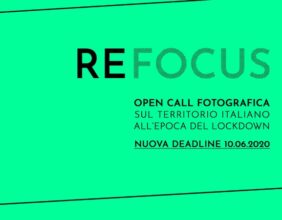On the occasion of Vassilij Kandinskij?s exhibition in Milan, Mostrami promotes Corsi Corsari?s initiative “The art of the great painter Kandinsky” … here, one of our flash interview with the professor Silvia Ferrari Lilienau: she will lead the participants discovering the great artist through a course and a subsequent guided tour of the exhibition at Palazzo Reale.
Who are you and what you deal with in the art world?
I am an art historian and critic. I?m the artistic director of the Civica Scuola di Pittura in Pavia and I?m teaching at the high school. I also talk and write about contemporary art.

Your passion for the art world comes from?
My passion was born reading Giulio Carlo Argan?s words. He is the author of “The History of Italian Art?. I still remember his words: “… the connection between the vestibule and the hall is, indeed, the plastic system of the stairs, that breaks into the shelter as a lava flow, in waves, but is shackled by balustrades that channel and make it boil as a swollen torrent.” So, even before I saw it, I thought about those stairs such as the mouth of a volcano.
If we were to introduce yourself in 3 words we should say..
You should say that I always love art, but certainly I do not love the art system.
Promoting art in Italy: how?
The promotion of art should go beyond the mere tourism. We should start from the art history education, which can not, however, disregard from a broader education. It would be necessary to start again from the education in a broadest sense.
Talking about art history education… shortly you?ll be engaged in a project about Kandinskij: tell us about the initiative!
Corsi Corsari promotes this initiative. There will be an introductory lesson about Kandinskij, his life and artworks and an optional guided tour of the exhibition ?Vassilij Kandinskij. La Collezione del Centre Pompidou?. It won?t be the introduction of the artworks of the exhibition but a presentation of Kandinsky?s artistic life, in order to better understand the entire exhibition.
How is it structured?
It?s a two hours a half lesson about Kandinskij, the early influences, the abstract turning point and the Bauhaus experience. Then, for those who want, the guided tour to the exhibition of the painter, to enjoy live something with which you are already familiar with.
It?s important to discover the poetics of the artist before the exhibition: why?
Because you learn not only watching something. Knowledge should be the previous requirement to be able to enjoy the artworks physicality in the exhibition. In front of an artwork you can feel something also without knowing, but the feeling fades without references that retain it.
Kandinsky: an adjective to describe him..?
Melodious.
What?s the artist?s artwork that you prefer and why?
Picture With A Black Arch, 1912. I relate it to a nice conversation with Giorgio Taborelli, years ago, when I was writing my essay for ?Arte. Storia Universale (Leonardo Arte)?, coordinated by him. The artworks you love the most always remember something special…?That Kandinsky? reminds me of him.

Why would you recommend it?
I?m not sure I would recommend it. I could only say that that artwork represents the first Kandinsky, freer compared to his artworks of the Bauhaus period.
A question that you would have found in this interview?
A question that I would address to everybody: why more and more people are visiting exhibitions and not museums?
I believe that a museum is ?crushing? for those people who have an ordinary knowledge: it?s too much, all at once. Then you should learn how to choose, you do not have to see everything in a museum, but what you really are interested in (although discovering something new is always lovely).
Here, however, we go back to the starting point: we must know firstly.
Exhibitions seem to be easier to be understood, because the topics are limited. We should consider it as an occasion of knowledge ? therefore it becomes a path to attain at museums with more awareness and, so, a chance to enjoy even those.
We thank Silvia and take this opportunity to invite all of you to follow this interesting artistic initiative comunicazione@mostra-mi.it
..in occasione della mostra a Milano di Vasilij Kandinskij, Mostrami promuove l’iniziativa di Corsi Corsari “L’arte del grande pittore Kandinskij”?vi proponiamo una delle nostre flash interview con la docente Silvia Ferrari Lilienau.. sarà lei a condurre i partecipanti nel viaggio alla scoperta del grande artista attraverso un corso ed una successiva visita guidata alla mostra di palazzo Reale..
Chi sei e di cosa ti occupi nel mondo dell?arte?
Sono una storica dell’arte, di tanto in tanto prestata alla critica, se mi appassiono a un artista. Sono direttore artistico della Civica Scuola di Pittura di Pavia, e insegno al liceo classico. Di arte contemporanea parlo e scrivo, più spesso parlo, negli ultimi tempi.

Da cosa è nata la tua passione per l?arte..?
La mia passione è nata leggendo le parole di Giulio Carlo Argan, autore di ?La Storia dell’arte italiana?, sull’atrio della Biblioteca Laurenziana di Michelangelo. Ricordo ancora le sue parole: «… il raccordo tra il vestibolo e la sala è infatti l’organismo plastico della gradinata, che irrompe nel ricetto come una colata di lava, a ondate, ma è incatenata dalle balaustre che la incanalano facendola ribollire come un torrente in piena.» Così, prima ancora di averla vista dal vivo, pensavo a quella gradinata come alla bocca di un vulcano; vederla qualche anno dopo non fu scoprirla, ma riconoscerla.
Se dovessimo presentarti in 3 parole di te dovremmo dire..
Che amo l’arte anche quando non l’amo, ma di certo non ne amo il sistema.
Promuovere l’arte in Italia: come?
Non riducendola a solo turismo. Bisognerebbe ripartire dall’educazione alla storia dell’arte, che non può però prescindere da un’educazione più ampia. Dunque bisognerebbe ripartire dall’educazione in senso lato. Poi non ci sarebbe più bisogno di chiedersi come, sarebbe naturale che accadesse.
A proposito di educazione alla storia dell’arte…a breve terrai un corso su Kandinskij. Ci vuoi parlare dell?iniziativa?
L’iniziativa è promossa da Corsi Corsari, organizzazione con la quale più volte ho collaborato. Si tratta di una lezione introduttiva alla mostra, con opzionale verifica sul campo. Non la presentazione delle opere in mostra, non vuole essere una guida preliminare, ma una presentazione della vicenda artistica di Kandinskij, della quale trovare poi conferma con la visita alla mostra.
Come sarà strutturata?
Una lezione di due ore e mezza su Kandinskij e il suo tempo, dunque le influenze iniziali, la svolta astratta, l’esperienza del Bauhaus. Poi, per chi vorrà, la visita alla mostra di Palazzo Reale per godere dal vivo di qualcosa con cui si è già familiarizzato.
Perché è importante approfondire la poetica dell?artista prima della mostra..?
Non si impara solo vedendo. La conoscenza dovrebbe essere il pregresso necessario per poi godere della fisicità delle opere in mostra. Di fronte alle opere si può provare qualcosa anche senza sapere, ma la sensazione sfuma senza riferimenti che la trattengano. Bisogna sapere cosa si sta guardando. Poi si è persino liberi di non apprezzare. Ma solo poi.
Un aggettivo per definire Kandinskij?
Musicale.
Qual è l?opera dell?artista che preferisci e perché?
Dipinto con arco nero, del 1912. Lo lego a una conversazione particolarmente bella con Giorgio Taborelli, anni fa, quando stavo scrivendo il mio saggio per Arte. Storia Universale (Leonardo Arte), di cui lui era il preziosissimo coordinatore. Le opere che si amano di più ricordano sempre qualcosa di speciale. Quel Kandinskij mi ricorda lui.

Perché la consiglieresti?
Non so se la consiglierei. Potrei solo dire che ben rappresenta il primo Kandinskij, che ha un fare più libero rispetto agli anni del Bauhaus.
Una domanda che non ti abbiamo fatto e che avresti voluto trovare in quest?intervista?
Quella che vorrei rivolgere a tutti: perché la gente visita sempre più mostre e sempre meno musei?
Io credo che un museo sia soverchiante per chi abbia una preparazione semplice: è insomma troppo, tutto in una volta. Anche se poi bisognerebbe imparare a scegliere, non necessariamente si deve vedere tutto, in un museo, ma quello che si vuole (benché scoprire qualcosa di nuovo sia sempre incantevole). Ecco però che si torna al punto di partenza: bisogna prima conoscere.
Le mostre danno l’illusione di essere consumabili con maggior rapidità, anche perché gli argomenti sono circoscritti. Farne un’occasione di conoscenza – poi chi ha detto che la conoscenza escluda l’emozione, anzi – diventa allora, in prospettiva, un cammino per approdare ai musei con più consapevolezza e, dunque, ben altra possibilità di godere anche di quelli. Che sono quasi sempre scrigni preziosi.
Ringraziamo Silvia e cogliamo l?occasione per invitare tutti voi a seguire quest?interessante iniziativa artistica comunicazione@mostra-mi.it





